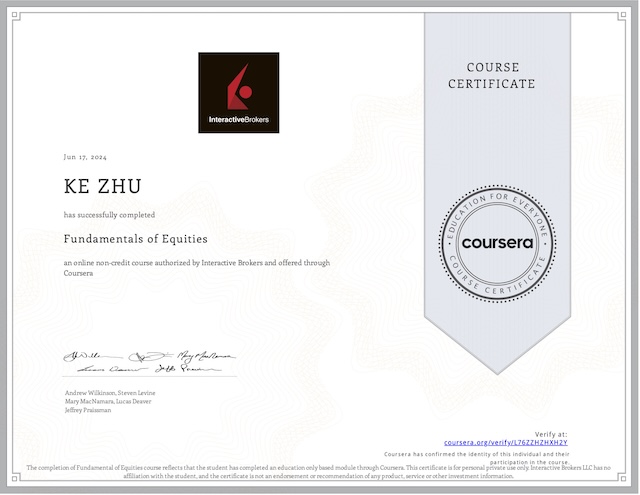Measure of Risks
VAR means variance. The variance of a portfolio is defined as a measure of its viability.
VaR means Value at Risk, is used by some finance people to quantify risk of an investment or portfolio. It is usually quoted in dollars for a given probability and time horizon.
Stress test is another measure, it is a methods of assessing risks to firms or portfolios. Instead of looking at the historical returns and how variable they are, let us look at the details and ask what vulnerability there are for various kinds of crisis. The stress tests are usually ordered by government. They would get information from the firm about all their interconnectedness with other institutions.
S&P 500
Standard & Poor’s 500 stock price index is used as a benchmark for returns. The law of large number does not working here, if all stocks are independent of each other, the law of large number will make the stock market as a whole almost constant. So there is finite dependence across stocks.
CAPM implies that the expected return of an asset is determined by its β. The β of a stock is a measure of how it relates to the stock market. It is the regression slope coefficient when the return on the asset is regressed on the return on the market.
By construction, the residuals (error terms) in a regression are uncorrelated with the fitted or predicted value. Market risk is the risk of the whole market. Idiosyncratic risk is the stock only risk. The variance of the return of a stock is equal to its β2 * variance of the market return (systematic risk) + variance of residuals in the regression (idiosyncratic risk).
Distribution
Normal distribution is a typical distribution for random variable in nature, there are many random variables (not all of them) follow normal distribution (for example, human heights, IQ, SAT, etc). It as two parameters mean and standard deviation. In finance, it tends NOT to follow this distribution, but having outliers and fat tails.
There are many other distributions that more accurately reflect financial returns. For example: Cauchy distribution with fat tail. The Cauchy distribution looks like a normal distribution except just trailing off to zero. You can be deceived by a fat tailed distribution into thinking that you are living in a stable world whose risk you understand, but there are big events occur from time to time.
Central Limit Theorem says that averages of a large number of independent identically distributed shocks (whose variance is finite) are normally distributed. But the theorem fails when underlying shocks are fat-tailed or lose their independence. So the average return of stock market (which tends to be fat-tailed) is not a good indication of real average over long internals of time. “Black swans” is a metaphor of fat tails.
Covariance
Covariance between the 2 returns is the probability weighted average. If 2 stocks are really independent, then the covariance is 0. Investors like it. If the 2 stocks are the “same”, there will be a non-zero covariance which is a flag of danger. It is possible that 2 stocks are exactly opposite to each other, only one of them will succeed, that will be a negative covariance.
You have to be looking at low covariance. Risk is determined by covariance. The market demands higher returns from higher β stocks. βi = COV(ri, rmarket) / VAR(rmarket). The CAPM model is an abstraction and an idealization. It assumes there are well-defined probabilities for everything. But not everyone behaves entirely in accordance with this model.
Insurance
Insurance is a very old idea, it is even used by non-human animals. The policyholders have a contract with the insurance company to protect them against certain well defined risks and for that they pay a premium (a regular payment) to the insurance company for its standing ready to manage those risks. Risk pooling is the source of all value of insurance. What is a risk for one person, is not a risk for the society at large if they are independent.
Risk Pooling
If n policies, each has independent probability p of a claim. Then the number of claims follows the binomial distribution. The standard deviation of the fraction of policies that result in a claim is [p(1-p)/n]1/2. According to the law of large numbers: as n gets large, standard deviation approaches zero, and the average of the results obtained from a large number of trials should be close to expected value. Unfortunately it is not so easy to make this idea work in practice, largely due to moral hazard and selection bias.
Moral Hazard occurs when people knowing they are insured take more risks. Selection Bias is when insurance company may not be able to see all of parameters of the risk, but customers may see more.
Insurance is often regulated at local level. The McCarran-Ferguson Act of 1945 delegated insurance regulation to the states. National Association of Insurance Commissioners NAIC, an non-profit, creates standardized suggested laws. It helps reduce the complexity of the US insurance system.
Portfolio Management
This is the idea of managing risk not through purchasing insurance policies, but through diversification, through owning variety of assets. You do have to take on risks in order to get a good investment. Risk is inherent to investing. You have to manage your risks by diversifying across a number of different assets, not putting your eggs in one basket.
The portfolio theory approach describes everyone as the same. You could be different from other persons because you could be more risk averse than others. But that variance could be adjusted by leveraging your portfolio up and down. Everyone should be doing the same thing. All that should matter to an investor is the performance of the entire portfolio (mean and variance).
Capital Asset Pricing Model (CAPM)
It is a model of the optimal portfolio. It asserts all investors will hold the optimal portfolio. What CAPM says it does not matter what your risk is, you want to hold all of assets with low to high risks. It will average out to be the best for you.
Security market line is the basic, the most impressive conclusion of the CAPM in finance. It is a relationship between the expected return on an asset and its beta.
ri = rfree + βi * (rmarket - rfree)This equation is the consequences of two things:
- the theory of forming an optimal portfolio
- the assumption that everybody does it
A negative beta stock moves opposite other risk. A negative beta is like an insurance, playing an insurance kind of role in your portfolio. The concept of insurance is fundamental to the concept of finance. They are really two different aspects of the same thing.
Short sales mean you borrow stocks and sell them, now you owe the shares to someone else. You would do that because you might think the price would go down. CAPM assumes that you could buy positive or negative amounts to find the optimal portfolio. We are going to allow short sales in our math, but we will assume that they won’t happen on average. No single investor will ever short a stock in equilibrium because then everybody in our model would be shorting that stock.
The market can stay irrational longer than you can stay solvent.
anonymous
Suppose we invest in 2 risky assets, the covariances matter because if they covariate positively, it makes them interact in a positive way increasing variance of the portfolio. Positive covariance is bad for your portfolio. Negative covariance is good.
Gordon Growth Model
Suppose a cash flow (with growth rate g) is x, x(1+g), x(1+g)2, … also suppose the discount rate r, then the present value of this cash flow is:
PV = x / ( r - g ), g < rg can be negative. Even assets whose payments are running down to zero, there is still a price for them today. It is OK to invest in declining industry, the problem is can you buy them less than the present value. If you are buying them for less than the present value, it is a good investment.
If the growth rate g is more uncertain than you thought, that should lower the price.
My Certificate
For more on Financial Markets, please refer to the wonderful course here https://www.coursera.org/learn/financial-markets-global
I am Kesler Zhu, thank you for visiting my website. Checkout more course reviews at https://KZHU.ai



